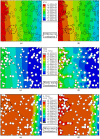Finite Element Analysis of Interfacial Debonding in Copper/Diamond Composites for Thermal Management Applications
- PMID: 28773098
- PMCID: PMC5551782
- DOI: 10.3390/ma10070739
Finite Element Analysis of Interfacial Debonding in Copper/Diamond Composites for Thermal Management Applications
Abstract
Copper/diamond (Cu/D) composites are famous in thermal management applications for their high thermal conductivity values. They, however, offer some interface related problems like high thermal boundary resistance and excessive debonding. This paper investigates interfacial debonding in Cu/D composites subjected to steady-state and transient thermal cyclic loading. A micro-scale finite element (FE) model was developed from a SEM image of the Cu/20 vol % D composite sample. Several test cases were assumed with respect to the direction of heat flow and the boundary interactions between Cu/uncoated diamonds and Cu/Cr-coated diamonds. It was observed that the debonding behavior varied as a result of the differences in the coefficients of thermal expansions (CTEs) among Cu, diamond, and Cr. Moreover, the separation of interfaces had a direct influence upon the equivalent stress state of the Cu-matrix, since diamond particles only deformed elastically. It was revealed through a fully coupled thermo-mechanical FE analysis that repeated heating and cooling cycles resulted in an extremely high stress state within the Cu-matrix along the diamond interface. Since these stresses lead to interfacial debonding, their computation through numerical means may help in determining the service life of heat sinks for a given application beforehand.
Keywords: Cr-coated diamond; copper/diamond composite; finite element analysis; interfacial debonding; thermal cyclic load.
Conflict of interest statement
The authors declare no conflict of interest. The funding sponsors had no role in the design of the study; in the collection, analyses, or interpretation of data; in the writing of the manuscript, and in the decision to publish the results.
Figures










References
-
- Zhang Y., Zhang H.L., Wu J.H., Wang X.T. Enhanced thermal conductivity in copper matrix composites reinforced with titanium-coated diamond particles. Scr. Mater. 2011;65:1097–1100. doi: 10.1016/j.scriptamat.2011.09.028. - DOI
-
- Ren S., Shen X., Guo C., Liu N., Zang J., He X., Qu X. Effect of coating on the microstructure and thermal conductivities of diamond–Cu composites prepared by powder metallurgy. Compos. Sci. Technol. 2011;71:1550–1555. doi: 10.1016/j.compscitech.2011.06.012. - DOI
-
- Chu K., Liu Z., Jia C., Chen H., Liang X., Gao W., Tian W., Guo H. Thermal conductivity of SPS consolidated Cu/diamond composites with Cr-coated diamond particles. J. Alloys Compd. 2010;490:453–458. doi: 10.1016/j.jallcom.2009.10.040. - DOI
-
- Xia Y., Song Y., Lin C., Cui S., Fang Z. Effect of carbide formers on microstructure and thermal conductivity of diamond-Cu composites for heat sink materials. Trans. Nonferrous Met. Soc. China. 2009;19:1161–1166. doi: 10.1016/S1003-6326(08)60422-7. - DOI
-
- Bai H., Ma N., Lang J., Zhu C., Ma Y. Thermal conductivity of Cu/diamond composites prepared by a new pretreatment of diamond powder. Compos. Part B. 2013;52:182–186. doi: 10.1016/j.compositesb.2013.04.017. - DOI
LinkOut - more resources
Full Text Sources
Other Literature Sources

